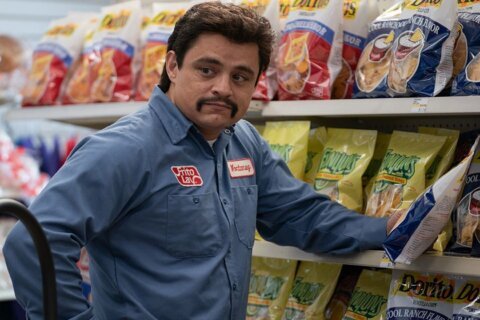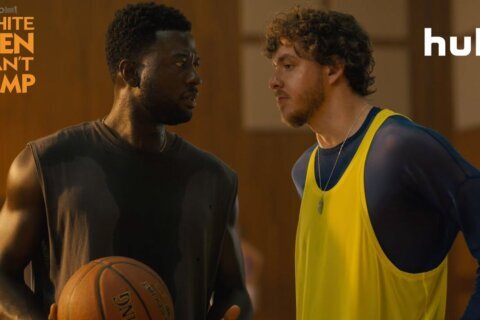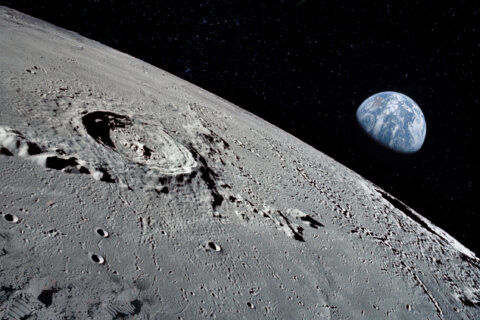WASHINGTON — The phrase “one of a kind” gets thrown around a lot, but Richard Linklater’s long-term experiment “Boyhood” is more deserving of the title than any movie in recent memory.
Thanks to its grand vision and careful execution, 12 years in the making, it instantly joins the list of movies that will be talked about for decades to come.
In 2002, Linklater cast then 6-year-old Ellar Coltrane as Mason; his own daughter, Lorelei, as Mason’s sister Samantha; and consistent collaborators Patricia Arquette (“Fast Food Nation”) and Ethan Hawke (“Before Sunrise”) as their divorced parents.
The group shot several scenes in 2002 and then waited a year. They shot several more scenes in 2003 and then waited another year. In 2004, they reunited once again to shoot more, and so on until Mason turned 18 and left for college.
The result is a deeply authentic, infinitely relatable coming-of-age story wrapped inside a fascinating time capsule.
Of course, “Boyhood” isn’t the first to attempt this “longitudinal study.”
Linklater’s own trilogy — “Before Sunrise” (1995), “Before Sunset” (2004) and “Before Midnight” (2013) — follows a similar method of checking in on the same characters in nine-year increments. But unlike “Boyhood,” that was done in three separate movies.
Michael Apted’s “Up” documentary series revisits the same group of British-born adults every seven years, starting with “Seven Up!” (1964) and most recently with “56 Up” (2012). Its middle chapter “28 Up” (1984) made the late Roger Ebert’s “Top 10 Favorite Movies.” But unlike “Boyhood,” these were documentaries of real lives.
To my knowledge, “Boyhood” is the first to try this experiment within the fictional structure of a single movie. The amount of discipline and long-term vision necessary to achieve this is really quite incredible, and so Ebert’s description of the “Up” series now applies to Linklater’s fictional work: “This ongoing film is an experiment unlike anything else in film history. … I defy anyone to watch without fascination.”
“I had this idea to film a little bit of it every year,” Linklater tells WTOP.
“I thought that it would be a powerful document of the kids growing up, the parents aging … and it would have this cumulative effect, that these rather intimate moments, over time, would mean something.”
Linklater explained the genesis of the idea in a one-on-one interview with WTOP, snippets of which can be heard to the right. The full interview is below:
The 12-year experiment provides a profound time capsule on a number of levels:
****
1. History & Politics
While TV’s “Mad Men” masterfully comments on history by recreating a specific era, “Boyhood” chronicles current history year-to-year. The film opens in 2002, just after Sept. 11 and just before the invasion of Iraq.
When TV news footage shows the violence in Fallujah, audiences have the realization that this movie was shot 12 years ago, but here we are today, still involved in Iraq.
“The beautiful thing is that we’re doing a period piece in real-time, so we don’t know the future,” Linklater says.
“By the end of this movie, he could have been waiting on his draft number if the country went a different way. You don’t know.”
Thus, “Boyhood” is a tragic reminder that history, indeed, repeats itself.
“I grew up in the Vietnam era, so when I was that age, it was like the war was just on TV,” Linklater says. “It meant nothing to me. It was just the backdrop.”
Decades later, “here we are again,” Linklater says.
There is another “war that goes on forever, but … from the kid’s point of view. He doesn’t really have the politics of it, he doesn’t really understand it, but it’s there.”
The film also shows how kids pick up on their parents’ politics.
There’s a debate over the 2004 election between presidential contenders George W. Bush and John Kerry. Later, there’s a “get out the vote” push during the 2008 election between Barack Obama and John McCain.
While Linklater clearly leans to the left, he grew up with a dad who voted for President Jimmy Carter and a step-dad who voted for President Richard Nixon. Linklater goes out of his way to criticize extremes on both sides, showing a stars-and-bars redneck with bubbling racism, followed by an airhead voter blinded by “hope and change” excitement.
****
2. Technology
Even more amusing is the film’s journey through various technological advances. Rather than going back and planting technological devices as props, the film uses current devices in real time.
“Boyhood” journeys from Apple computers to iPods, from iPhones to Skype, and culminates with a Facebook debate where Mason says mankind has willingly turned itself into social robots.
In the realm of video games, Mason moves from playing a portable Gameboy Advance to the X-Box first-person shooter game “Halo” and then to throwing physical punches on the cordless Nintendo Wii.
At one point, his stepfather complains about “computer games at the table,” as Mason’s stepbrother plays a “20 Questions” game on a handheld device instead of interacting with the family.
What perceptive foreshadowing of the “distracted” smartphone era, before it even took off!
****
3. Pop Culture
Also, the film charts various trends and fads in pop culture.
As a young kid, Mason watches “Dragonball Z.”
At a slightly older age, he and his friends dress in their best Hogwarts attire to stand in line for the latest Harry Potter book.
In their tween years, Mason’s friend says she doesn’t get the appeal of the “Twilight” book series.
And as a teenager, he complains that his girlfriend doesn’t like his three favorite movies that summer: “The Dark Knight,” “Tropic Thunder” and “Pineapple Express.”
****
4. Music
An even more subtle pop culture commentary comes on the soundtrack.
We open with Coldplay’s “Yellow,” as Mason’s sister sings Britney Spears and their mother listens to Sheryl Crowe.
We then progress through an array of 21st century tunes, all the way to Daft Punk and Arcade Fire.
It all culminates with “Hero” by Family of the Year, a band name that meta-references the annual check-ins with this single family.
Linklater is no stranger to music, launching Matthew McConaughey to a killer classic rock soundtrack in “Dazed and Confused” (1993) and giving Jack Black a glorious “face-melting” stage in “School of Rock” (2003).
There’s even a serendipitous moment when the music actually blends with the narrative in a self-reflexive way. As we enter the last third of the film, Mason’s father gives him a custom-made CD that he calls the “Black Album,” reuniting The Beatles with carefully arranged songs from the solo careers of Paul McCartney, George Harrison, John Lennon and Ringo Starr.
As Hawke explains, “The first four tracks, you get ‘Band on the Run,’ into ‘My Sweet Lord,’ into ‘Jealous Guy’ into ‘Photography.’ Paul takes you to the party, George talks about God, John says, ‘Nah, it’s all about love and pain,’ and Ringo says, ‘Hey can’t we just enjoy what we have while we have it?'”
The movie then proceeds in an identical order, first with a birthday party, then a church sermon, then the love and pain of a romance and breakup and finally a “live and let live” nature trip with college buddies.
When asked if this was intentional, Linklater laughed and says, “Not really, [but] that’s beautiful!”
Even he doesn’t know his subconscious brilliance.
****
5. Physical Transformation
Still, beyond all the historical and cultural musings, the biggest treat of the time capsule is watching the actors literally grow up before our very eyes.
Haircuts change, bodies change and voices change. We even see the acting skills develop, turning the film’s only flaw into its biggest strength as Coltrane goes from an over-acting rookie to a naturalistic performer.
In the case of Lorelei Linklater, the film serves as almost a giant home movie documenting the director’s real-life daughter.
“Some kids go with their dad to Six Flags, we made a movie a few days a year,” Linklater says.
“There was a little moment somewhere along the way where she asked if her character could die, but I was like, ‘No, that’s a little dramatic for what we’re trying to do here.'”
****
Linklater’s resistance to this request is more than just a funny father-daughter moment. It’s the key to the film’s success. Throughout the movie, Linklater resists the urge to make arbitrary “things happen.”
The best example of this comes as Mason hangs out with his high school buddies, drinking beers in the basement and throwing a saw blade into a piece of plywood. As the boys rough house in front of the plywood, we gasp in fear that one might fly back dangerously into the blade. It never happens.
“That’s a good example of how conditioned audiences are because it never crossed my mind shooting that. I didn’t even notice the blade was behind his head the way audiences do,” Linklater says.
“I was at that camp out [as a kid]. We threw blades and no one lost a little finger, or no one caught one in the jugular. You get through childhood. Most of the bad [stuff] doesn’t happen.”
In this way, Linklater avoids forced plot points in favor of intimate life moments that seem mundane from scene-to-scene, but which add up to an epic tapestry on the human condition. This is what makes the film so much more than its time capsule gimmick, transfixing viewers for nearly three hours.
“We go to movies to see the extraordinary, the things we don’t see in our regular lives, [but ‘Boyhood’] was this collection of little intimate moments,” Linklater says.
“It’s not that they’re not dramatic, because once you’re in the kid’s point of view it is dramatic.”
While radio and TV host Art Linkletter famously interviewed children for “Kids Say the Darndest Things,” Linklater is just as perceptive in capturing those little pieces of childhood.
Mason learns about sex by finding a lingerie magazine in the street. He learns about death by staring at a dead bird and burying it next to his house. And he learns about art by taking photographs of a high school football game.
“Boyhood” is the closest thing to the footsteps and firecrackers of Terrence Malick’s “Tree of Life” (2011), only with a more linear narrative structure.
While the coming-of-age story is the meat of the script, some of the film’s biggest life lessons come from the adult characters. Arquette goes through various stages of motherhood, divorce and remarriage. She moves on from past mistakes with the motto “don’t look back,” living in the present to make ends meet with a checkbook at the dinner table and tragically looking at the future with a teary-eyed question: “Is this all there is?”
Most compelling is Hawke’s out-of-home father, who teaches Mason life lessons every other weekend when he has custody of the kids, similar to Furious Styles in “Boyz n the Hood” (1991). During a trip to the bowling alley, Mason keeps rolling gutter balls and laments the lack of bumpers. His father says, “You don’t want the bumpers. Life doesn’t give you bumpers.”
It may be Hawke’s most honest performance to date.
“I think he’s just a really substantial artist. He always has been,” Linklater says.
“I met him when he was 23. He had written a book, he had directed a short movie, he had a hit music video, he was one of the top actors in Hollywood, he had his own theater company, all that at 23.”
The working relationship is a collaboration in every sense of the word, with Hawke routinely calling Linklater at 2 a.m. with ideas for how to approach a scene, the director says.
“That’s what a collaborator is. You push each other, and you get to a place that neither of you could have got to alone. Ethan and I have always had that relationship,” Linklater says.
“Twenty years ago we were working together for the first time in Vienna on ‘Before Sunrise’ and at the end people asked, ‘Are you guys ever going to work together again?’ And we look at each other and said, ‘I hope so.'”
With “Boyhood,” the planets have most definitely aligned. It is Linklater’s apotheosis, cementing himself among the most important filmmakers of the last 25 years. He has proven he can expand or condense time at will, unfolding a story that takes place in a single day like “Slacker” (1991) and “Dazed and Confused (1993), or following characters during a long period of time like the “Before Sunrise” trilogy and now “Boyhood.”
As a mentor tells Mason in the darkroom of his high school photography class, “Any dipsh*t can take pictures… But art, that’s special.”
For Linklater, it’s the realization that we humans are nothing more than a collection of our memories, and great artists should tap into their own personal experiences to unlock life’s most basic truths.
“The depth of your perception of your own experience is all you really have,” Linklater says. “If you don’t value your own experience and your own perceptions, then you kind of have nothing.”
★ ★ ★ ★
The above rating is based on a 4-star scale. See where this film ranks in the Fraley Film Guide. Follow WTOP Film Critic Jason Fraley on Twitter @JFrayWTOP, read his blog The Film Spectrum, listen Friday mornings on 103.5 FM and see a full list of his stories on our “Fraley on Film” page.
Follow @WTOP and WTOP Entertainment on Twitter and WTOP on Facebook.








